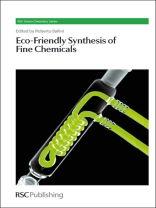The 20th century has seen a phenomenal growth in the global economy and continuous improvement in the standard of living in the industrialized countries. Sustainable development has become an ideal target in recent years and in the early 1990s the concept of ’Green chemistry’ was launched in the USA as a new paradigm, and since 1993 it has been promoted by the National Science Foundation (NSF) and the Environmental Protection Agency (EPA). The success of the pharmaceutical industry is, in large part, due to the towering achievement of organic chemistry, a mature science which emerged as a distinct discipline well over 150 years ago, however this has been both a blessing and a curse. Many of our most reliable strategies for assembling target molecules employ reactions which are fifty to one hundred years old and are often named in honour of their discoverers. During these early years, the chronic toxicological properties of chemicals were often completely unknown and many unwittingly became indispensable tools of the trade. Early pioneers in green chemistry included Trost (who developed the atom economy principle) and Sheldon (who developed the E-Factor). These measures were introduced to encourage the use of more sustainable chemistry and provide some benchmarking data to encourage scientists to aspire to more benign synthesis. Green chemistry is essentially the design of chemical processes and procedures that reduce or eliminate the use, or the generation, of hazardous substances. Green chemistry is a growing area of research and an increasing number of researchers are now involved in this field. The number of publications has dramatically increased and new recognition of advances made is necessary with respect to other research areas. The synthesis of ’Fine Chemicals’ represents one of the main goals in organic synthesis and this new book extensively examines the main processes and procedures for their preparation under eco-friendly conditions.
The book is a collection of selected research topics delivered by scientists involved in some of the more prominent fields of green chemistry. It is devoted to the synthesis of fine chemicals by the use of alternative eco-friendly solvents (ionic liquids, polyethylene glycol, water, etc.), supported organic catalysis, microwave irradiation or high pressure as contributors to more efficient processes, photochemistry as a green procedure and solvent-free processes. Each chapter gives an introduction to the various methods or procedures and their contribution to green chemistry and a variety of the most representative examples of the eco-friendly synthesis of fine chemicals are reported and discussed. In addition, there is a chapter dedicated to the application of simple reaction to the synthesis of complex molecules.The chapters are all written by authors who are experts in their field and are exhaustively referenced and the book will be invaluable for researchers and industrialists as well as academia.
Innehållsförteckning
Catalysis in non Conventional Reaction Media The Contribution of Photochemistry to Green Chemistry Supported Organic Bases: A Green Tool for Carbon-Carbon Bond Formation Task Specific Ionic Liquids for Fine Chemicals Green Procedures for the Synthesis of Useful Molecules Avoiding Hazardous Organic Solvents and Toxic Catalysts Simple Reactions for the Synthesis of Complex Molecules High Pressure: A Clean Activation Method for Sustainable Organic Reactions Environmentally Benign Chemical Synthesis via Mechanochemical Mixing and Microwave Irradiation
Om författaren
Roberto Ballini is a Full Professor of Organic Chemistry at the Faculty of Sciences of the University of Camerino. The research interest of Prof. Ballini is mainly dedicated to Organic Synthesis, with particular attention to the field of eco-friendly processes (Green Chemistry). The growth and the survival of the chemical industry is the industrialised countries are connected with the possibility to develop synthetic processes able to combine high yields and selectivity with the use of eco-compatible reagents, catalysts and solvents and waste minimization. To reach the goal of environmental protection, the right approach is to focus attention on primary prevention (minimizing or avoiding waste formation) rather than on secondary remediation (mainly consisting in waste treatment). In this context our group has developed a variety of collaborations with other Universities (Rome, Bologna, Venezia, Urbino, Parma, Perugia, Chieti, Texas-USA, Badajoz-Spain, Siviglia-Spain, Nijmegen-Netherland, etc.). Of particular interest is the Chemistry of aliphatic nitro compounds, employed for new generations of carbon-carbon single bond and carbon-carbon double bond, for the cleavage of the carbon-carbon bond, and for their use as the key building blocks in the synthesis of important targets such as natural products featuring enhanced biologically activity. Other special fields of extensive interest also concern: (i)












